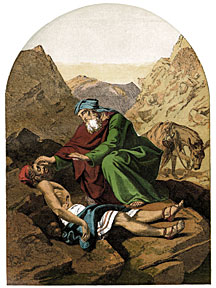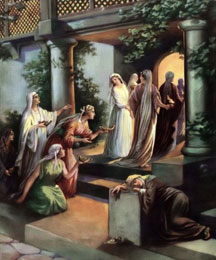The Parables of Christ, Part III: Parable of the Good Samaritan
 by Fr. James Buckley, FSSP
by Fr. James Buckley, FSSP
From the February 2011 Fraternity Newsletter
Since a parable manifests a truth of the supernatural order by comparing it to some image from nature or the life of man, it is all important to discover the point of comparison between the two. As Saint Basil the great observed, “The parables do not correspond to the exterior image in all its parts of the subject to be considered but direct the attention to the principal truth.” Nevertheless, that basic comparison, as Our Lord’s own explanations of some parables demonstrate, can be extended to different parts of the parable.
A great clue to understanding the point of comparison will be found in the words introducing or concluding the parable. The parable of the Good Samaritan, for example, was introduced by a lawyer’s question, i.e., “And who is my neighbor?” It answers the question by providing a concrete image and not by offering a philosophical definition. At its conclusion, Our Lord emphasizes its point when He asks, “Which of these three, in thy opinion, was neighbor to him that fell among the robbers?” (Luke 10:36)
Similarly, Our Lord first admonished His hearers “to pray and not to faint” before presenting to them the parable of the unjust judge. In a few lines He tells how the sheer persistence of the widow forced one who feared neither God nor man to grant her justice. His concluding remark makes the supernatural truth obvious, i.e., “And will not God revenge his elect who cry to him day and night and will he have patience in their regard? I say to you, that he will quickly revenge them.” (Luke 18:7–8)
Though the parable of the two sons has no introduction, it has a significant conclusion. Our Lord tells His audience that when a father asked his two sons to work in his vineyard, the first one said that he would not but the second said that he would. The one who agreed to work did not, but the one who refused to work repented and worked. When Our Lord asked them which did his father’s will, they replied “the first.” Christ reveals the comparison in the conclusion: “Amen I say to you, that the publicans and the harlots shall go into the kingdom of God before you. For John came to you in the way of justice and you did not believe him. But the publicans and the harlots believed him: but you, seeing it did not afterwards repent, that you might believe.” (Matt. 21:32)
 It is the conclusion of the parable of the ten virgins which also indicates the comparison (i.e., “Watch ye therefore, because you know not the day or the hour” [Matt. 25:13]). In this parable the foolish virgins, by neglecting to take oil with their lamps, failed to welcome the bridegroom at his arrival and, consequently, merited the punishment of not participating in the wedding feast. The comparison is this. Just as the virgins were obliged to have their lamps burning when the bridegroom arrived, so too the faithful are obliged to prepare for Christ’s coming in judgment by their good works. Those who do will enter into everlasting life, but those who do not will be condemned by those dreadful words, i.e., “Amen I say to you, I know you not.”
It is the conclusion of the parable of the ten virgins which also indicates the comparison (i.e., “Watch ye therefore, because you know not the day or the hour” [Matt. 25:13]). In this parable the foolish virgins, by neglecting to take oil with their lamps, failed to welcome the bridegroom at his arrival and, consequently, merited the punishment of not participating in the wedding feast. The comparison is this. Just as the virgins were obliged to have their lamps burning when the bridegroom arrived, so too the faithful are obliged to prepare for Christ’s coming in judgment by their good works. Those who do will enter into everlasting life, but those who do not will be condemned by those dreadful words, i.e., “Amen I say to you, I know you not.”
This central comparison is extended to other parts of the image. The bridegroom who bars the foolish virgins from the wedding feast is Christ who will reward each man according to his deeds. The wedding feast, therefore, represents the everlasting happiness of heaven. The uncertainty regarding the time of the bridegroom’s arrival signifies that the time of Christ’s second coming is hidden from us. There are many other incidents in the parable which have no supernatural counterpart. It is of no significance, for example, that while the bridegroom tarried all the virgins slept. This is merely a detail enhancing the realism of Christ’s story. The same is true of the refusal of the wise virgins to share their oil with the foolish.
Next time I will look at the parable of the unjust steward.
February 5, 2011








